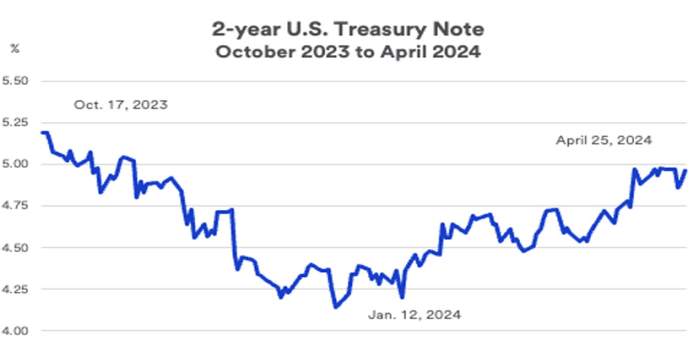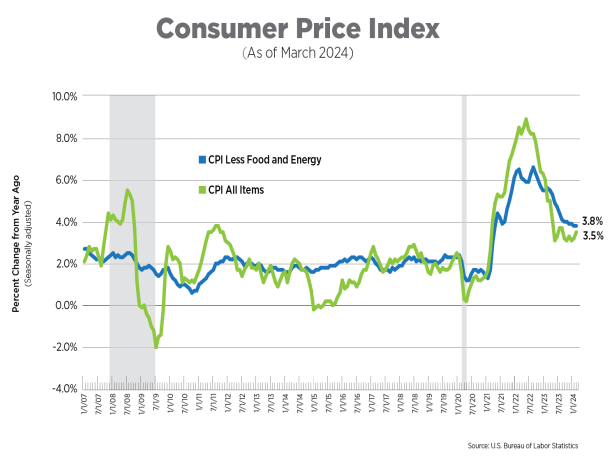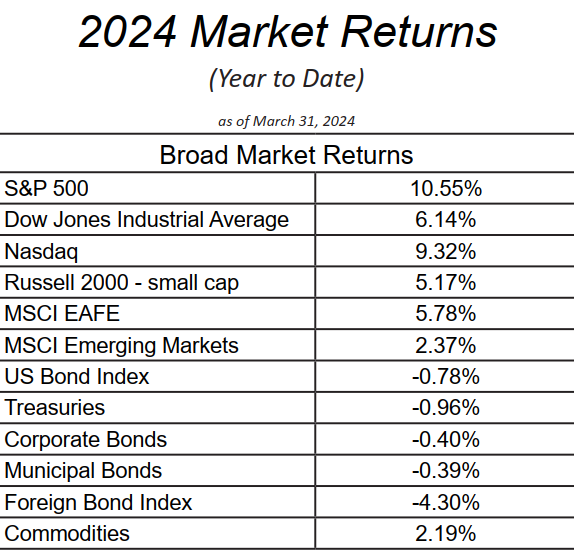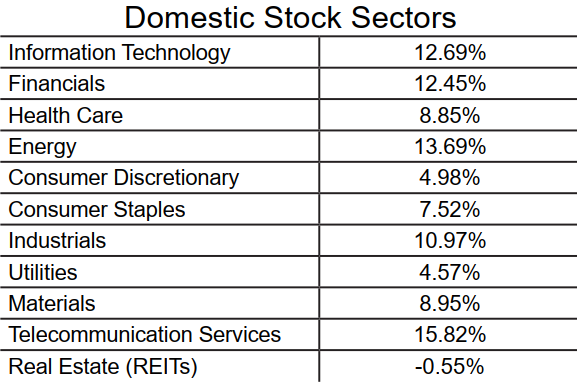What's Next for Investors? An analysis of 2024's First Quarter Market Trends
Published: 05/06/2024
By: Christopher Coyle, Idaho Trust Bank Chief Financial Officer

Market Insights
A periodic newsletter from Idaho Trust Bank
Most major global stock indices, especially domestically, had a strong start to the year. The healthy performance was due in part to expectations that inflation pressures had subsided and looser credit conditions along with lower interest rates would prevail. However, more recently, inflationary forces have begun to pick up, causing expectations that the Federal Reserve Bank might reduce the Fed Funds rate to get pushed back further in the year.
This possibility of a more restrictive monetary policy stance has caused interest rates to move higher and led to more volatility in the financial markets in recent weeks. Other factors contributing to higher interest rates include a strong job market, solid corporate earnings, and unwavering consumer spending.
The Federal Reserve Bank
The last time the Federal Reserve Bank raised the Fed Fund rate was July 2023. At the start of the year, the financial markets were anticipating multiple interest rate cuts in 2024. However, three straight Consumer Price Index (CPI) reports of higher-than-expected readings have changed that outlook. While inflation rates have fallen from exceptionally high levels, getting closer to the 2% target rate appears to be more challenging than most had expected (see chart on next page). As of this writing, expectations from market observers are that the Fed will reduce rates one or two times by the end of this year.

As a result of this shift in expectations and a strong economic picture, the interest rate on the two-year U.S. Treasury note has moved higher since December. Investors appear to be concerned about high U.S. government debt levels. Higher interest rates inflate the cost of paying off existing and future debt.
Mortgage rates remain at high levels at least by more recent historical comparisons. The average 30-year fixed rate reached 7.55%, which is a nearly two-decade high. The average rate has risen by half a point since August. This rise has coincided with the recent selloff in the fixed-income market. The high levels have put pressure on purchasing and refinancing activity. Housing starts remain under pressure, as demand is strong but affordability is a big obstacle.

Another issue facing lenders is the commercial real estate sector. Since a high point in May 2022 – commercial real estate has declined about 16%, according to Green Street. While many businesses have returned to the office, significant vacancies remain. Office spaces have been hit the hardest, with an approximate 31% decline in value since the Federal Reserve started raising rates. A shift in the attitude toward remote work has also contributed to the uncertainty surrounding the Real Estate sector.
First-Quarter Review
Most equity markets experienced solid gains in the first quarter of 2024. This strong performance follows an exceptionally strong market performance in the prior year. While broad indices SP500 (US) and the EAFE (developed international) rose steadily at 10.55% and 5.78%, respectively, technology stocks advanced at a faster pace. The Telecommunications services sector rose 15.82%, and the tech-heavy NASDAQ rose 9.32%. Generally speaking, recent history has seen tech-focused companies grow and fall more dramatically than the broader index. Other sectors that experienced strong gains were Energy and Financials. The two groups with the weakest performance were REITs and Utilities, likely related to higher interest rates and uncertainties surrounding demand.

Conclusion
Given the large number of unknowns surrounding inflation levels, it is likely that volatility levels will remain high into the summer months. Therefore, markets could continue to be volatile in the near term. However, we believe that the long-term investment outlook remains solid, with a healthy economic backdrop and higher rates, which should benefit fixed-income returns going forward. The market will be closely watching for indications on future Fed policy and earnings calls in the coming weeks.
1. Consult an Idaho Trust Bank financial consultant for more details. Securities and insurance products are offered through LPL Financial and its affiliates, Member FINRA/SIP. Idaho Trust Bank is not a registered broker/ dealer and has a brokerage affiliate arrangement with LPL Financial. Idaho Trust Bank is a separate company from LPL Financial. Investment accounts generally under $300,000; Insurance and Annuities of all sizes.
2. Please see the Idaho Trust Bank Schedule for Fees. Investment accounts generally over $300,000.
3. Please see the Idaho Trust Bank Schedule of Fees. Investment accounts generally over $500,000. Certain products may be provided by a Financial Consultant of Idaho Trust Financial is utilized: (1) Securities and insurance products are offered through LPL Financial and its affiliates, Member FINRA/SIPC; (2) Idaho Trust Bank is not a registered broker/dealer and has a brokerage affiliate arrangement with LPL Financial; and, (3) Idaho Trust Bank is a separate company from LPL Financial, Idaho Trust Bank does not provide tax or legal advice. Overlay Asset Management utilizes external and/or internal managers selected by Idaho Trust Bank.
4. Certain products may be provided by a Financial Consultant of Idaho Trust Financial. Securities and insurance products are offered through LPL Financial and its affiliates, Member FINRA/SIPC. Idaho Trust Bank is not a registered broker/dealer and has a brokerage affiliate arrangement with LPL Financial. Idaho Trust Bank is a separate company from LPL Financial. Idaho Trust Bank does not provide tax or legal advice.
5. Exchange Traded Funds (ETF), mutual funds, and individual stocks are subject to risks and fluctuate in value. Neither asset allocation nor diversification assure a profit or protect against loss. International investing involves special risks including increased volatility, political risks, and differences in auditing and other financial standards. Small-cap stocks have historically experienced greater volatility than average. High yield, lower-rated securities generally entail greater market, credit and liquidity risks than investment grade securities and may include higher volatility and higher risk of default. Bond prices are sensitive to changes in interest rates, and a rise in interest rates can cause a decline in their prices. Past performance is no guarantee of future results. No representation is hereby made of the risk and/or return of any particular portfolio. There is no guarantee that any suggested investment strategy will work in any market. You should fully and carefully consider all objectives, risks, expenses and fees before you invest.
6. Portfolios are illustrative only. ActualLifeNeedsTM Portfolios will vary from time to time as determined by Idaho Trust Bank. No representation is hereby made of the risk and/or return of any particular portfolio. There is no guarantee that any suggested investment strategy will work in any market. You should fully and carefully consider all objectives, risks, expenses, and fees before you invest. Past performance is no guarantee of future results.
Exchange Traded Funds (ETF), mutual funds and individual stocks are subject to risks and fluctuate in value. Neither asset allocation nor diversification assure a profit or protect against loss. International investing involves special risks including increased volatility, political risks, differences in auditing and other financial standards. Small-cap stocks have historically experienced greater volatility than average. High yield, lower-rated securities generally entail greater market, credit and liquidity risks than investment grade securities and may include higher volatility and higher risk of default. Bond prices are sensitive to changes in interest rates and a rise in interest rates can cause a decline in their prices. Past performance is no guarantee of future results. For more information about performance of Idaho Trust Strategies and our performance calculation methodology, please contact us. Actual client performance may vary from the performance of model portfolios and/or any strategy. No representation is hereby made of the risk and/or return of any particular portfolio. There is no guarantee that any suggested investment strategy will work in any market. You should fully and carefully consider all objectives, risks, expenses, and fees before you invest.
Portfolios are illustrative only. Actual LifeNeeds™ Portfolios will vary from time to time as determined by Idaho Trust Bank. The Idaho Trust investment strategies will vary from time to time as determined by Idaho Trust Bank. The information and analysis expressed herein are for general information only and are not intended to provide specific advice or recommendations for any individual or entity. Information contained herein has been obtained by sources we consider reliable but is not guaranteed. Any opinions expressed are based on our interpretation of data available to us at the time of the original publication of the report. These opinions are subject to change at any time without notice.
NOT A DEPOSIT • NOT FDIC INSURED • NOT INSURED BY ANY FEDERAL GOVERNMENT AGENCY • NOT GUARANTEED BY THE BANK • MAY GO DOWN IN VALUE
Rev. 03.31.2024 ©Idaho Trust Bank, 2024. All Rights Reserved.

